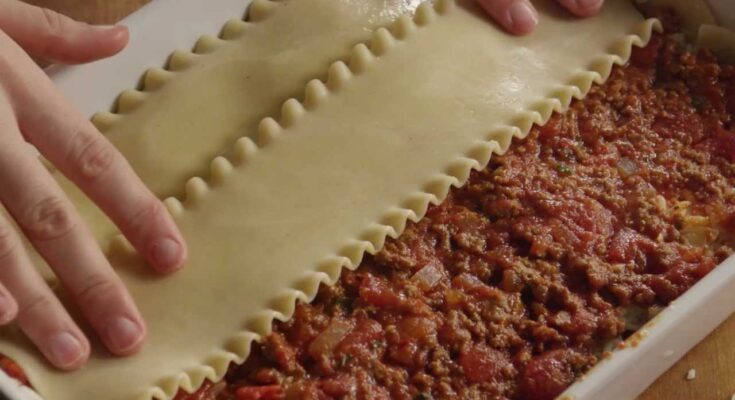Traditional Lasagna Recipe: Let’s face it—when you think of comfort food, lasagna is right there at the top of the list. This oven-baked beauty is the culinary definition of layers of love. Whether it’s a big family dinner or a cozy meal for two, traditional lasagna has a way of bringing people together. But what makes it so universally loved?
First, it’s all about those layers. You’ve got savory meat sauce mingling with gooey melted cheese, sandwiched between tender sheets of pasta. It’s hearty, rich, and soul-satisfying. The combination of textures and flavors is nothing short of magic.
Then there’s the nostalgia factor. Many of us grew up with the scent of tomato sauce and oregano wafting through the kitchen, signaling that lasagna night had arrived. It’s a dish that feels like home. And while there are plenty of creative takes out there—spinach lasagna, white sauce lasagna, even vegan varieties—nothing beats the classic.
This guide is for those who want to master the art of making traditional lasagna the old-school way, with real ingredients, patience, and love. Trust me, it’s worth every step.
A Peek into Its Italian Roots
Lasagna may be a household name worldwide now, but its origins trace back centuries to the Italian region of Emilia-Romagna. There, the traditional recipe, known as “Lasagna alla Bolognese,” features layers of ragù (a slow-cooked meat sauce), béchamel, and handmade pasta sheets.
Interestingly, the word “lasagna” originally referred to the pot it was cooked in, not the dish itself. Over time, though, it became synonymous with this layered masterpiece.
Classic lasagna recipes vary across Italy. In Naples, for example, you might find boiled eggs and meatballs layered in. In the north, béchamel sauce replaces ricotta. What we consider “traditional” in the U.S. is often a fusion of these regional Italian styles, combined with local twists.
Still, the heart of the dish remains the same: rich sauce, creamy cheese, and pasta baked to bubbly perfection. Understanding its roots helps us appreciate why this dish continues to endure across cultures and generations.
Ingredients You’ll Need
Core Ingredients for the Meat Sauce
The soul of traditional lasagna is the meat sauce—flavorful, slow-cooked, and packed with depth. Here’s what you’ll need:
- Ground beef: Choose 80/20 for a balance of flavor and fat.
- Italian sausage (optional): Adds a spicy, herby kick.
- Onion and garlic: These are your aromatic base.
- Crushed tomatoes: A high-quality canned variety works perfectly.
- Tomato paste: Adds thickness and a concentrated flavor.
- Olive oil: For sautéing.
- Salt, pepper, and sugar: To balance and enhance the flavors.
- Italian seasoning: A mix of oregano, basil, and thyme works well.
- Red wine (optional): Gives the sauce richness and depth.
Simmering the sauce low and slow allows the flavors to marry beautifully, creating that hearty, comforting taste we all crave in a good lasagna.
Cheese Layer Essentials
Cheese is the creamy glue that binds lasagna together. For a traditional version, you’ll need:
- Ricotta cheese: Soft, creamy, and perfect for layering.
- Mozzarella cheese: Go for low-moisture, shredded mozzarella for the best melt.
- Parmesan cheese: Freshly grated is best for that salty, nutty finish.
- Egg: Added to the ricotta mixture to help it set while baking.
This cheesy combo brings richness and texture to each bite. If you want extra depth, consider mixing in a bit of mascarpone or provolone, but traditionalists usually stick to the big three.
Pasta and Seasoning Components
Don’t underestimate your noodles—they’re more than just a vessel. Here’s what you’ll need:
- Lasagna noodles: You can use no-boil or classic boil-and-layer pasta. Either works, but classic noodles give more control.
- Salted water: If you’re boiling noodles, salt the water generously.
- Fresh herbs: Basil, parsley, and oregano can be used both in the sauce and cheese mixture.
- Black pepper: Adds a little kick to the creamy components.
The pasta should be al dente, meaning tender but with a slight bite. Overcooking the noodles before baking can lead to a soggy lasagna, and no one wants that!
Step-by-Step Guide to Making Traditional Lasagna
Step 1: Preparing the Rich Meat Sauce
Start by heating a few tablespoons of olive oil in a large skillet over medium heat. Toss in finely chopped onions and cook them until translucent. Then, add minced garlic and stir for about 30 seconds. The aroma at this point? Pure heaven.
Next, add the ground beef and Italian sausage (if using), breaking it apart with a wooden spoon. Brown the meat thoroughly until no pink remains. Drain any excess fat to avoid a greasy lasagna.
Now, stir in the tomato paste and let it cook for 2–3 minutes. This caramelizes it slightly and enhances the flavor. Add your crushed tomatoes, a splash of red wine if using, and the seasonings: salt, pepper, sugar, and Italian herbs.
Lower the heat and let the sauce simmer gently for at least 30–40 minutes. Stir occasionally. The longer it cooks, the richer it gets. Taste and adjust the seasoning if needed.
The result? A thick, meaty, flavor-packed sauce that’s the heart and soul of your lasagna. It’s tempting to eat it by the spoonful—but save it for layering!
Step 2: Making the Creamy Ricotta Mixture
This step is all about creating the perfect cheese layer—creamy, rich, and just the right amount of tangy. Start with ricotta cheese as your base. In a mixing bowl, combine:
- 2 cups of ricotta cheese
- 1 large egg (this helps the cheese firm up while baking)
- ½ cup grated Parmesan cheese
- Salt and freshly ground black pepper to taste
- 2 tablespoons chopped fresh parsley or 1 tablespoon dried parsley
If you’re feeling adventurous, a pinch of nutmeg adds a subtle warmth that elevates the flavor. Mix everything together until it’s well combined and smooth. You want it spreadable, not runny, so if it’s too dry, add a splash of milk. If too loose, toss in a little more Parmesan.
This cheese blend becomes the creamy counterpoint to your meaty tomato sauce and chewy noodles. It adds that perfect bite that makes lasagna irresistibly delicious.
Pro tip: Make this mixture in advance and let it chill in the fridge. It thickens slightly and becomes easier to spread during assembly.
Step 3: Boiling and Prepping the Lasagna Noodles
If you’re using classic lasagna noodles, proper preparation is key to building a solid structure. Fill a large pot with water, add a generous amount of salt, and bring it to a boil. Add your noodles and cook until just shy of al dente—typically 1 to 2 minutes less than the package instructions.
Why not cook them fully? Because they’ll continue to cook in the oven, and overcooked noodles turn mushy. You want them tender but still firm.
Once boiled, carefully drain the noodles and lay them flat on a clean kitchen towel or parchment paper. This prevents sticking and tearing. If you pile them while they’re still wet, they’ll fuse together—disaster for your layering process.
Some people swear by no-boil noodles, and they can work beautifully too. Just be sure your sauce is a bit thinner to allow the noodles to absorb enough moisture while baking.
If you’re in a pinch, you can prep these a day ahead—just drizzle them lightly with olive oil, layer with parchment, and refrigerate until ready to use.
Step 4: Layering Like a Pro
Now comes the fun part: building your lasagna! Preheat your oven to 375°F (190°C) and grab a 9×13-inch baking dish. The layering process is crucial—too much sauce can lead to sogginess, and too little cheese will make it dry. Here’s a foolproof sequence:
- Spread a thin layer of meat sauce on the bottom of the dish. This prevents the noodles from sticking.
- Lay down the first layer of noodles, slightly overlapping the edges.
- Add a layer of the ricotta mixture, spreading it evenly with a spoon.
- Sprinkle a layer of mozzarella cheese, about 1 to 1½ cups.
- Add another layer of meat sauce, spreading it out to the edges.
- Repeat the process: noodles, ricotta, mozzarella, sauce—until you’ve used up your ingredients.
Finish with a final layer of noodles, topped with remaining sauce and a generous sprinkle of mozzarella and Parmesan.
You should aim for three full layers of filling and noodles. Don’t worry if it looks like a lot—it will compress during baking. Cover the dish with foil (tip: spray it with oil so the cheese doesn’t stick), and it’s ready to bake.
Step 5: Baking It to Perfection
Slide your beautifully layered lasagna into the oven and bake covered for 25–30 minutes. This helps everything heat evenly and keeps the top from burning. Then, remove the foil and bake for another 15–20 minutes until the cheese is bubbling and golden brown.
Here’s the hardest part: let it rest for at least 15–20 minutes before cutting. This allows the layers to set, making it easier to serve tidy slices.
Optional but amazing: broil the top for 1–2 minutes to crisp the cheese—just keep an eye on it!
You’ll know it’s ready when your kitchen smells like an Italian grandmother’s kitchen, and the bubbling cheese looks too good to resist.
Tips for the Best Homemade Lasagna
Mistakes to Avoid
Even seasoned cooks can mess up lasagna. Here are common pitfalls and how to avoid them:
- Overcooked noodles: Remember, they keep cooking in the oven.
- Skipping the rest time: Slicing it too soon leads to messy servings.
- Too much sauce: Makes the dish watery—go for balanced layering.
- Cheese overload on top: You want it gooey, not greasy.
- Undersalting the layers: Taste as you go—cheese, sauce, and even noodles need seasoning.
Ingredient Substitutions and Enhancements
You can stick with the traditional ingredients, or give it a twist:
- Swap ground beef with turkey or pork for a different flavor.
- Add chopped spinach to the ricotta mixture for a veggie boost.
- Use fresh lasagna sheets if available—they make a big difference.
- Try a béchamel layer instead of ricotta for a Northern Italian feel.
- Infuse olive oil with garlic and brush noodles for a subtle flavor lift.
No matter how you tweak it, remember: lasagna is about balance. Keep each layer distinct, and you’ll end up with a dish that’s both impressive and incredibly satisfying.
Final Thoughts and Serving Suggestions
What to Serve with Traditional Lasagna
Lasagna is a meal in itself, but pairing it with the right sides can elevate your dinner to a full-on Italian feast. The rich and savory nature of lasagna calls for accompaniments that balance out its heaviness and bring freshness to the table.
Start with a crisp green salad—something simple like romaine, arugula, or mixed greens tossed in a light vinaigrette. The acidity of the dressing cuts through the richness of the cheese and meat sauce. Add some cherry tomatoes, red onions, or cucumbers for extra crunch.
A loaf of crusty garlic bread is a must. Whether you make it from scratch or buy it premade, it’s perfect for mopping up all that extra sauce left on your plate. You can even make cheesy garlic bread by topping slices with shredded mozzarella and broiling them briefly.
For something warm and comforting, consider roasted vegetables like zucchini, bell peppers, or carrots. Their sweetness complements the savory profile of the lasagna beautifully.
Don’t forget about beverages. A glass of red wine like Chianti, Sangiovese, or even a bold Zinfandel pairs wonderfully with traditional lasagna. For a non-alcoholic option, try sparkling water with a splash of lemon.
Finish the meal with something light for dessert—think tiramisu, panna cotta, or even fresh fruit with a drizzle of balsamic glaze.
With these side dishes, your lasagna dinner will feel like a festive Italian gathering—right in your own home.
How to Store and Reheat Leftovers
One of the best things about lasagna? It tastes even better the next day. That’s because all those flavors have more time to meld together. Here’s how to store and reheat it properly.
If you have leftovers, let the lasagna cool completely before covering it. Use an airtight container or wrap the baking dish tightly with foil or plastic wrap. Store in the refrigerator for up to 4–5 days.
For longer storage, freeze individual portions. Slice the lasagna and place each serving in a freezer-safe container or wrap them in foil and store in a zip-top bag. They’ll keep well for up to 2 months.
When it’s time to reheat, you’ve got a few options:
- Oven method (best): Preheat to 350°F (175°C), cover the lasagna with foil, and bake for 20–25 minutes (or longer if frozen) until heated through.
- Microwave method: Place a slice on a microwave-safe plate, cover loosely with a lid or paper towel, and heat in 1-minute intervals until hot.
- Skillet method (for crispy edges): Add a bit of water to a non-stick skillet, cover, and heat on low until warmed through.
Avoid reheating multiple times. Instead, portion out what you need. This keeps the texture and flavor intact and ensures your lasagna stays as delicious as the first time.
FAQs about Traditional Lasagna Recipe
1. Can I make lasagna ahead of time?
Absolutely. You can assemble the lasagna a day in advance and refrigerate it unbaked. When you’re ready, bake it directly from the fridge—just add an extra 10–15 minutes to the baking time.
2. How do I keep lasagna from falling apart when slicing?
Letting the lasagna rest after baking is key. Allow at least 20 minutes for the layers to set before cutting. Use a sharp knife and a spatula for neat slices.
3. Is there a vegetarian version of this recipe?
Yes! Swap the meat sauce with a hearty vegetable-based sauce using mushrooms, zucchini, spinach, and lentils. Keep the cheese layers the same or try adding a béchamel sauce for extra creaminess.
4. What’s the difference between ricotta and cottage cheese in lasagna?
Ricotta has a finer, creamier texture and is more traditional. Cottage cheese is lumpier and has a slightly tangier flavor. Some people prefer cottage cheese for a lighter feel, but ricotta is classic for a reason.
5. Can I use fresh pasta sheets instead of dry noodles?
Definitely! Fresh pasta sheets cook faster and result in a more tender bite. You won’t need to pre-boil them, just layer directly. They also give the lasagna a more authentic Italian texture and taste.
Conclusion
Traditional lasagna isn’t just a recipe—it’s a ritual. From simmering the meat sauce to layering noodles with creamy cheese, every step brings you closer to that satisfying first bite. While it may take some time and effort, the results are more than worth it. Plus, with its make-ahead ease and freezer-friendliness, it’s the perfect dish for busy nights, family gatherings, or comfort food cravings.
Now that you have a step-by-step guide, all you need is a little patience, quality ingredients, and a big appetite. Buon appetito!



